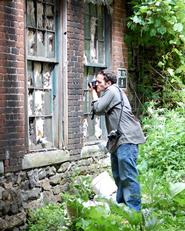
Local history can be difficult to incorporate into the needs of the present. In the Mohawk Valley and particularly in Utica, the debate continues over whether historic sites should be preserved or the often dormant, rundown buildings should be demolished to support needed economic development. While spectacular renovation efforts on buildings such as the Hotel Utica and the Stanley Theatre take showcase preservation, many abandoned buildings in Utica are demolished to promote relevant modern use of the space, or because they are potential targets of arson. Arson is the top destroyer of historic buildings, and this year, 22 have been confirmed in the Utica area.
For Greg Huffaker '09, the question of what to do with the old buildings in Utica and the Mohawk Valley has been the genesis of a project that combines art and history. The rising senior is photographing regional historic sites, as well as interviewing residents and studying history texts and historical documents. Huffaker is collaborating with Sylvia de Swaan, visiting instructor of art last year, to pursue a project funded by an Emerson Foundation Grant program. From his photographs and research, he will create a presentation to show to area schools and historical societies. In addition, Huffaker will have a show of his work both at Hamilton and in Utica, and he plans to create a website and a book of his work, as well.
In his hometown of Santa Fe, N.M. Huffaker says, there is "an obsession with preservation." There are very specific guidelines for preserving old and historic sites. Consequently, Huffaker was interested in the practice of preservation in the Mohawk Valley, where historical and economic motives come into conflict. Often, individuals will advocate preservation and economic progress at the same time, but the two are not always compatible. In his photography and research, Huffaker says, he has tried to be objective, not supporting any particular course of action, but instead portraying the building and its history.
To evoke a sense of the past in an image of a current building can be difficult. Huffaker says, "It's easy at an illustrative level. The hardest is to keep the artistry in mind…to try to find an image to depict history." His project has taken him to sites all over the Mohawk Valley, from the Oriskany battlefield to the Utica Psychiatric Center.
As his advisor, de Swaan has been an invaluable resource, Huffaker says, helping by pointing out his best pictures as well as locating sites, taking him to investigate old factories and walk railroad tracks. He also relies on chance: "I usually just drive around and park my car somewhere," he says. In addition, Huffaker has relied on area residents. "It's great how excited people get about it," he says. "Everyone has an opinion – people care so much about the buildings."
When asked about how his project started, Huffaker says that it just "popped up." He had explored Utica before, driving around with a friend, and when he received an e-mail describing the Emerson Foundation Grants, he decided to apply. A history and art dual major, he says that after graduating, he may apply for a grant to undertake a similar project with a larger focus area. He plans to attend law school, but says, "I plan to do photography all my life."
Huffaker, along with 16 other students, received funding this summer from the Emerson Foundation Grant program. The program, established in 1997, provides students with significant opportunities to work collaboratively with faculty members, researching an area of interest.
-- by Laura Bramley
